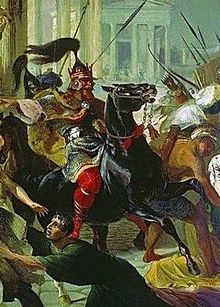Generic
Generic (from the Vandal Gaisarīks, 'prince of the javelin'; c. 389-Carthage, 25 January 477) was king of the Vandals and the Alans between 428 and 477. He was a key player in the conflicts that occurred in the fifth century in the Western Roman Empire, and during his almost fifty-year reign he elevated a relatively insignificant Germanic tribe to the status of a Mediterranean power.
History
Illegitimate son of the Vandal king Godegisilio, he is supposed to have been born in the vicinity of Lake Balaton around the year 389. He was elected king in 428 on the death of his half-brother Gunderic. Brilliant and well-versed in military art, he immediately sought a way to increase the power and prosperity of his people, who at that time resided in Hispania Bética and had suffered attacks by the most numerous Visigoths. Thus, shortly after acceding to the throne, Genserico decided to cede Hispania to his rivals, using the powerful fleet created under the reign of his predecessor.
Taking advantage of the disputes between Boniface, the Roman governor of North Africa, with the metropolis, 50,000 Vandals and Alans (80,000 with other peoples) —15,000 men crossed the Strait of Gibraltar in the spring of 429, although it is believed that the men-at-arms would be only about 20,000. Although other sources speak of up to 40,000 Alans, 50,000 Silingos and 80,000 Asdingos. Some authors maintain that even 80,000 barbarians is an exaggerated figure, and reduce the migration to 50,000. Starting from Tarifa and Iulia Traducta, they disembarked in Ceuta. After several victories over weak and divided Roman defenders, they took control of a territory that included present-day Morocco and northern Algeria, placing the city of Hippo under siege, which they would take after fourteen months of hard fighting. The following year, Emperor Valentinian III had to recognize Genserico as sovereign of all these territories.
In 435 Genseric reached an agreement with the Roman Empire, whereby the Vandal kingdom became foederati of Rome with the concession of Numidia. In return, he was to pay tribute, desist from attacking Carthage, and send his son Huneric to Rome as a hostage.However, in 439 Gaiseric took—apparently without a fight—the city of Carthage, capturing the imperial fleet docked there.. With this movement, he made the Vandals masters of the Western Mediterranean, seizing maritime bases of great strategic and commercial value: the Balearic Islands, Corsica, Sicily and Sardinia. Rome, deprived of one of the largest cereal production areas in the old world, will henceforth have to buy grain from North Africa for its own supply.
In 455, the Roman Emperor Valentinian III was assassinated, succeeded by Petronius Maximus. Considering the peace treaty signed with Valentinian in 442 broken, Genseric landed in Italy and marched on Rome, whose population rebelled against the new emperor and killed him. Three days later - on April 22, 455 - the Vandals took the city without resistance and sacked it.
Pope Leo the Great was unable to prevent Genseric's vandals, upon reaching the gates of Rome, from invading the defenseless city, which was sacked for two weeks. However, the gesture of the Pope, who, defenseless and surrounded by his clergy, came out in the way of the invader to ask him to stop, at least prevented Rome from being set on fire and managed to prevent the basilicas of Saint Peter, Saint Paul and Saint Paul from being looted. of San Juan, where part of the terrified population took refuge.
Although the vandals looted a great deal of gold, silver, and valuables, the looting did not greatly damage the city. Gaiseric took with him to Carthage as a hostage Licinia Eudoxia, Valentinian's widow, and her two daughters, Placidia and Eudoxia; the latter would marry her son and her successor, Hunerico.
In 468, the kingdom of Gaiseric faced the last joint military effort of the two halves of the Roman Empire. However, the Vandal king defeated a powerful fleet led by the later Byzantine emperor Basilisk at the Battle of Cape Bon. In the summer of 474 he signed the perpetual peace with Constantinople, by which Byzantium recognized the Vandal sovereignty over the North African provinces, the Balearic Islands, Sicily, Corsica and Sardinia.
In his internal politics, Genserico tolerated Catholicism at times, although he demanded the conversion to the Arian doctrine of his closest advisers, and proceeded to numerous confiscations of property of the Catholic Church, which would thus become a powerful opposition force to the Vandal monarchy. He also gave rise to persecutions of Catholics who did not accept Arianism, such as the persecutions in North Africa in which Armogastes, Arquinimo and Saturn were martyred in 462.
He bloodily weakened the traditional Vandal-Alana nobility, replacing it with a court devoted to his own family, and he lightened the fiscal pressure on the population at the expense of rich families of Roman origin and the Catholic clergy.
Generic died on January 25, 477, being succeeded by his son Huneric.
Contenido relacionado
821
379
139

